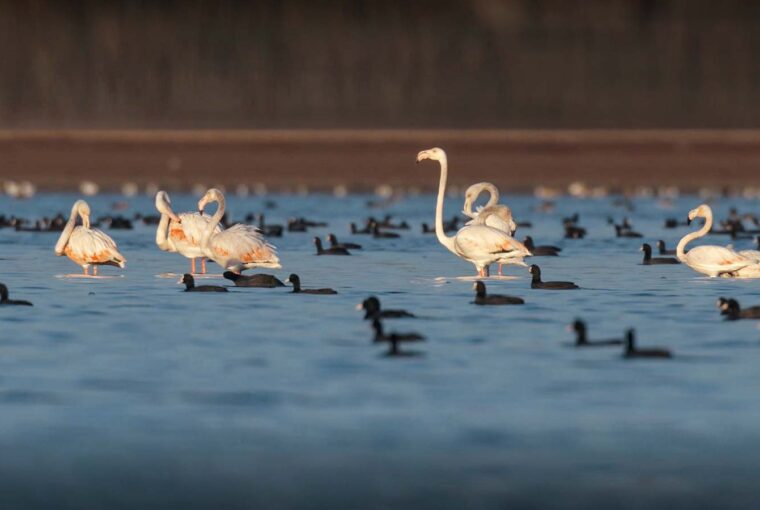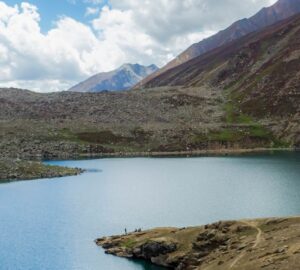Pakistan’s Salt Range Wetlands Complex provides a stunning winter home for migratory birds from as far as Siberia. There is an urgnet need to protect this fragile and unique ecosystem from the ecological damage it is now facing.
If you get off the motorway exit at Kallar Kahar in the Salt Range and go past the lake adjacent to the motorway, you will eventually find a series of three other picturesque lakes – Khabeki, Uchali and Jhalar, which have been declared a Ramsar Site in 1996 as globally important wetlands. The Ramsar Convention is an intergovernmental treaty that provides the framework for national action and international cooperation for the conservation and wise use of wetlands. The brackish/salt water lakes in the area known as the Soon Valley are an important refuge for migratory birds from as far as Siberia. Bird migration is one of the wonders of the natural world, with birds flying thousands of kilometers to find the best habitats for feeding and breeding.
Each year many migratory birds take a brief stopover of approximately 3-4 weeks in the cold months in Soon Valley to rebuild their strength to continue their long journey. In the winters, one can find hundreds of pink flamingoes in Uchali Lake, which is a stunning sight. At Kallar Kahar Lake near the motorway, several species of waterfowl inhabit the wetland in winter. These include the Common Pochard, Mallard, Purple Heron, Common Coot and Little Grebe. The Common Moorhen and Purple Swamp Hen are permanent residents in the wetlands of Kallar Kahar, while the White-headed Duck is critically endangered and can be observed in Kallar Kahar only in the winters.
The Soon Valley is a special place, unique in an arid country like Pakistan, with its abundance of streams, lakes and hills. The valley sits atop the second largest mineral salt deposits in the world in the Salt Range. This is a fragile and unique ecosystem created millions of years ago with the evaporation of the Tethys Sea, which rose up when the Indian plate collided with the Asian plate, forming the sub-continent. The Salt Range extends from Mianwali in the west, to Jhelum in the east and at its western end it forms a semi loop, creating the area called the “Soon Valley”. The average elevation of the valley is 2000 feet above sea level.
The valley, in fact, acts as a basin – the rainwater runs down and collects in the lakes. The over use of tube wells, which pump out water for irrigation and drinking purposes in the surrounding villages, had started drying up the groundwater tables in the area. Approximately 60% of the population of Soon Valley is engaged in water intensive farming and most of the fertile land is under cultivation. Then 2010’s record-breaking rains came and a little miracle occurred in the Soon Valley. The lakes replenished themselves and the ground water table went up.
Khabeki Lake, which had become a puddle, went back to its original size. WWF-Pakistan had initiated its conservation activities in the valley back in 2001 near Khabeki Lake, where they built a field office. Later, the Pakistan Wetlands Programme focused its efforts on the three large lakes of Kallar Kahar, Khabeki and Uchali, the smaller lake of Jhalar, and the nearby lake of Nammal. This Salt Range Wetlands Complex, as it was termed by the programme, is also the core habitat for the endemic Punjab Urial, a wild species of sheep.

The Khabeki wetland is brackish and muddy, and attracts many species of wintering birds, amongst them the endangered White-headed Duck. During the last decade the number of waterfowl visiting the lake has significantly decreased, as the fragile bio-diversity of the wetland has been seriously disturbed by hunting and fishing in the lake. The Uchali Lake has salt water and is an ideal wetland for the migrating Greater Flamingoes.
Uchali Lake, which is the largest saltwater lake in the valley, is a strange greenish yellow colour and no one knows for sure how deep it is. The local people believe that there is a volcano hidden beneath the surface of the Uchali Lake due to which the colour of the water keeps changing! The government has now constructed a jetty for boating in the lake and different tracks for walking around it.
The other main problem facing this valley is that of deforestation. Once the hills surrounding Soon Valley were heavily forested and indeed one can still see the remnants of the thick forest in Sakesar, one of the highest peaks in the Salt Range, which is a protected area owned by the Pakistan Air Force where no trespassers are allowed. This is where the Pakistan Air Force’s main radar is located atop the peak. The mountains of the Salt Range were once covered with evergreen forests and thorn forests. There are many factors that have contributed to large-scale deforestation in the Salt Range.
The cutting down of trees has overall affected the watershed areas and lowered water levels in the region. Over the years the villagers have cut down the trees primarily to use as fuel wood as there is no provision of gas in this area. It is estimated that on average 10-15 kg of wood is used daily during the summer in each household and this figure only increases during the winter season.
Forest fires have also destroyed many of the trees, as have mining activities in the area. The people of the Soon Valley, however, are learning about new ways to protect their remaining forests. Biogas digesters which use cow and buffalo dung to produce gas were introduced to the area by WWF-Pakistan.
An awareness campaign for school children was also carried out to highlight the ecological significance of the area in general and wetlands in particular. Awareness materials such as booklets and banners were distributed. One of the outcomes of this awareness was a community-based watch and ward system that began to protect the forest and wildlife in the vicinity of Khabeki Lake. The local villagers started to value the natural assets of the area and a visible decline was seen in the hunting of wildlife and water-birds as well as in the cutting of trees.
The WWF-Pakistan field office at Khabeki Lake has now been turned into a Wetlands Information Centre with a bird-watch tower, conference room and ecological exhibits. However, with the end of the Pakistan Wetlands Programme, not many activities take place at the Information Center now. The programme had taken up some other initiatives to promote eco-tourism in Soon Valley and several lake view-points, bird hides and campsites were set up at some of the lakes which still exist. Many tourists visit the area on their own in the winter months to see the lakes and the birds that visit, staying at the comfortable Pakistan Tourism Development Corporation (PTDC) hotel in Kallar Kahar.
This little projection of the area as a tourist site by WWF-Pakistan has now become one of the priorities of the Punjab Government. The government is initiating uplift schemes worth Rs200 million in the Soon Valley as a first step towards turning it into an eco-friendly tourist attraction. A master plan in this regard has been devised by the Punjab Government’s Urban Unit, and forwarded to the tourism department for final approval by the provincial cabinet in the near future.
This is a welcome step as uncontrolled tourism, infrastructure development and exhaustive agricultural activities are taking their toll on the natural treasures of Soon Valley. The government needs to promote eco-friendly tourism in the area otherwise the valley may face irreversible ecological damage.





